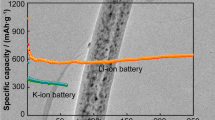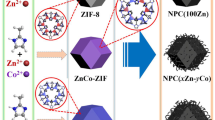Abstract
We investigated the possible use of a hexa-cata-hexabenzocoronene nanographene (HCHN) as an anode material for Mg-ion batteries (MIBs) implementing the B3LYP-gCP-D3/6-31G* scheme. The Mg cation or atom is adsorbed on the HCHN with the adsorption energy of − 200.3 or − 4.7 kcal/mol. The energy barrier related to transferring Mg cation on the HCHN surface was calculated to be 7.5 kcal/mol, producing the diffusion coefficient of 1.90 × 10−8 cm2/s. It shows that the ion mobility is high and the rate of charge or discharge is fast. The calculated specific storage capacity of HCHN is 589.4 mAh/g and the great cell voltage is 4.23 V that is generated by the interaction of cation-π between Mg2+ and HCHN, which is strong. The HCHN is considered an ideal candidate to be used as an anode material in MIBs since its storage capacity and ion mobility are high, and it has a large cell voltage.






Similar content being viewed by others
Data availability
All data will be available if required.
References
Dahn JR, Zheng T, Liu Y, Xue J (1995) Mechanisms for lithium insertion in carbonaceous materials. Science 270:590
Johannes MD, Swider-Lyons K, Love CT (2016) Oxygen character in the density of states as an indicator of the stability of Li-ion battery cathode materials. Solid State Ionics 286:83–89
Cai C, Gao X, Teng Q, Kiran R, Liu J, Wei Q, Shi Y (2020) Hot isostatic pressing of a near α-ti alloy: temperature optimization, microstructural evolution and mechanical performance evaluation. Mater Sci Eng A 140426
Kim H, Kim JC, Bianchini M, Seo DH, Rodriguez-Garcia J, Ceder G (2018) Recent progress and perspective in electrode materials for K-ion batteries. Adv Energy Mater 8:1702384
Chen S, Hassanzadeh-Aghdam M, Ansari R (2018) An analytical model for elastic modulus calculation of SiC whisker-reinforced hybrid metal matrix nanocomposite containing SiC nanoparticles. J Alloys Compd 767:632–641
Guo H, Qian K, Cai A, Tang J, Liu J (2019) Ordered gold nanoparticle arrays on the tip of silver wrinkled structures for single molecule detection. Sensors Actuators B Chem 300:126846
Shetti NP, Dias S, Reddy KR (2019) Nanostructured organic and inorganic materials for Li-ion batteries: a review. Mater Sci Semicond Process 104:104684
Zhu W, Zhang Z, Chen D, Chai W, Chen D, Zhang J, Zhang C, Hao Y (2020) Interfacial voids trigger carbon-based, all-inorganic CsPbIBr 2 perovskite solar cells with photovoltage exceeding 1.33 V. Nano-Micro Lett 12:1–14
Zhang W (2020) Parameter adjustment strategy and experimental development of hydraulic system for wave energy power generation. Symmetry 12:711
Yan H, Xue X, Chen W, Wu X, Dong J, Liu Y, Wang Z (2020) Reversible Na+ insertion/extraction in conductive polypyrrole-decorated NaTi2 (PO4) 3 nanocomposite with outstanding electrochemical property. Appl Surf Sci 530:147295
Er D, Li J, Naguib M, Gogotsi Y, Shenoy VB (2014) Ti3C2 MXene as a high capacity electrode material for metal (Li, Na, K, Ca) ion batteries. ACS Appl Mater Interfaces 6:11173–11179
Singh N, Arthur TS, Ling C, Matsui M, Mizuno F (2013) A high energy-density tin anode for rechargeable magnesium-ion batteries. Chem Commun 49:149–151
Huie MM, Bock DC, Takeuchi ES, Marschilok AC, Takeuchi KJ (2015) Cathode materials for magnesium and magnesium-ion based batteries. Coord Chem Rev 287:15–27
Xie J, Wen D, Liang L, Jia Y, Gao L, Lei J (2018) Evaluating the validity of current mainstream wearable devices in fitness tracking under various physical activities: comparative study. JMIR mHealth uHealth 6:e94
Besenhard JO, Winter M (2002) Advances in battery technology: rechargeable magnesium batteries and novel negative-electrode materials for lithium ion batteries. ChemPhysChem 3:155–159
Beheshtian J, Baei MT, Peyghan AA, Bagheri Z (2013) Nitrous oxide adsorption on pristine and Si-doped AlN nanotubes. J Mol Model 19:943–949
Beheshtian J, Peyghan AA, Bagheri Z (2013) Arsenic interactions with a fullerene-like BN cage in the vacuum and aqueous phase. J Mol Model 19:833–837
Shi M, Xiao P, Lang J, Yan C, Yan X (2020) Porous g-C3N4 and MXene dual-confined FeOOH quantum dots for superior energy storage in an ionic liquid. Adv Sci 7:1901975
Peyghan AA, Noei M, Bagheri Z (2014) Functionalization of the pristine and stone-wales defected BC 3 graphenes with pyrene. J Mol Model 20:2539
Shi M, Narayanasamy M, Yang C, Zhao L, Jiang J, Angaiah S, Yan C (2020) 3D interpenetrating assembly of partially oxidized MXene confined Mn–Fe bimetallic oxide for superior energy storage in ionic liquid. Electrochim Acta 334:135546
Noei M, Peyghan AA (2013) A DFT study on the sensing behavior of a BC 2 N nanotube toward formaldehyde. J Mol Model 19:3843–3850
Zuo C, Sun J, Li J, Zhang J, Asundi A, Chen Q (2017) High-resolution transport-of-intensity quantitative phase microscopy with annular illumination. Sci Rep 7:1–22
Peyghan AA, Beheshtian J (2020) The influence of stone-Wales defects in nanographene on the performance of Na-ion batteries. J Mol Graph Model 98:107578
Liu Y, Hu B, Wu S, Wang M, Zhang Z, Cui B, He L, Du M (2019) Hierarchical nanocomposite electrocatalyst of bimetallic zeolitic imidazolate framework and MoS2 sheets for non-Pt methanol oxidation and water splitting. Appl Catal B Environ 258:117970
Peyghan AA, Baei MT, Hashemian S, Torabi P (2013) Adsorption of CO molecule on AlN nanotubes by parallel electric field. J Mol Model 19:859–870
Beheshtian J, Noei M, Soleymanabadi H, Peyghan AA (2013) Ammonia monitoring by carbon nitride nanotubes: a density functional study. Thin Solid Films 534:650–654
Wang M, Hu M, Hu B, Guo C, Song Y, Jia Q, He L, Zhang Z, Fang S (2019) Bimetallic cerium and ferric oxides nanoparticles embedded within mesoporous carbon matrix: electrochemical immunosensor for sensitive detection of carbohydrate antigen 19-9. Biosens Bioelectron 135:22–29
Akbari F, Foroutan M (2020) The effect of two layers of graphene with a striped pattern on wettability parameters of the biodroplets. Adsorption 26:407–427
Wang M, Yang L, Hu B, Liu J, He L, Jia Q, Song Y, Zhang Z (2018) Bimetallic NiFe oxide structures derived from hollow NiFe Prussian blue nanobox for label-free electrochemical biosensing adenosine triphosphate. Biosens Bioelectron 113:16–24
Karaal Ş, Köse H, Aydin AO, Akbulut H (2015) The effect of LiBF4 concentration on the discharge and stability of LiMn2O4 half cell Li ion batteries. Mater Sci Semicond Process 38:397–403
Peyghan AA, Noei M (2014) A theoretical study of lithium-intercalated pristine and doped carbon nanocones. J Mex Chem Soc 58:46–51
Wang Y, Yao M, Ma R, Yuan Q, Yang D, Cui B, Ma C, Liu M, Hu D (2020) Design strategy of barium titanate/polyvinylidene fluoride-based nanocomposite films for high energy storage. J Mater Chem A 8:884–917
Chen C, Wang X, Wang Y, Yang D, Yao F, Zhang W, Wang B, Sewvandi GA, Yang D, Hu D (2020) Additive manufacturing of piezoelectric materials. Adv Funct Mater 30:2005141
Qiu T, Shi X, Wang J, Li Y, Qu S, Cheng Q, Cui T, Sui S (2019) Deep learning: a rapid and efficient route to automatic metasurface design. Adv Sci 6:1900128
Narita A, Wang X-Y, Feng X, Müllen K (2015) New advances in nanographene chemistry. Chem Soc Rev 44:6616–6643
Wu X, Zhang Z, Soleymanabadi H (2020) Substituent effect on the cell voltage of nanographene based Li-ion batteries: a DFT study. Solid State Commun 306:113770
Kumar S, Pola S, Huang C-W, Islam MM, Venkateswarlu S, Tao Y-T (2019) Polysubstituted hexa-cata-hexabenzocoronenes: syntheses, characterization, and their potential as semiconducting materials in transistor applications. J Org Chem 84:8562–8570
Wright JS, Rowley C, Chepelev L (2005) A ‘universal’B3LYP-based method for gas-phase molecular properties: bond dissociation enthalpy, ionization potential, electron and proton affinity and gas-phase acidity. Mol Phys 103:815–823
Kruse H, Goerigk L, Grimme S (2012) Why the standard B3LYP/6-31G* model chemistry should not be used in DFT calculations of molecular thermochemistry: understanding and correcting the problem. J Org Chem 77:10824–10834
Peng C, Bernhard Schlegel H (1993) Combining synchronous transit and quasi-Newton methods to find transition states. Israel J Chem 33:449–454
Schmidt MW, Baldridge KK, Boatz JA, Elbert ST, Gordon MS, Jensen JH, Koseki S, Matsunaga N, Nguyen KA, Su S, Windus TL, Dupuis M, Montgomery JA (1993) General atomic and molecular electronic structure system. J Comput Chem 14:1347–1363
O’Boyle N, Tenderholt A, Langner K (2008) cclib: A library for package-independent computational chemistry algorithms. J Comput Chem 29:839–845
Peyghan AA, Noei M, Tabar MB (2013) A large gap opening of graphene induced by the adsorption of Co on the Al-doped site. J Mol Model 19:3007–3014
Zhou X, Zhao T, An L, Zeng Y, Yan X (2015) A vanadium redox flow battery model incorporating the effect of ion concentrations on ion mobility. Appl Energy 158:157–166
Zhang X, Yang C, Pan Y, Weng M, Xu L, Liu S, Yang J, Yan J, Li J, Shi B (2019) Monolayer GaS with high ion mobility and capacity as a promising anode battery material. J Mater Chem A 7:14042–14050
Vineyard GH (1957) Frequency factors and isotope effects in solid state rate processes. J Phys Chem Solids 3:121–127
Vessally E, Soleimani-Amiri S, Hosseinian A, Edjlali L, Bekhradnia A (2017) A comparative computational study on the BN ring doped nanographenes. Appl Surf Sci 396:740–745
Denis PA, Iribarne F (2014) Theoretical investigation on the interaction between beryllium, magnesium and calcium with benzene, coronene, cirumcoronene and graphene. Chem Phys 430:1–6
Rasul S, Suzuki S, Yamaguchi S, Miyayama M (2012) High capacity positive electrodes for secondary Mg-ion batteries. Electrochim Acta 82:243–249
Shao Y, Gu M, Li X, Nie Z, Zuo P, Li G, Liu T, Xiao J, Cheng Y, Wang C, Zhang J-G, Liu J (2014) Highly reversible Mg insertion in nanostructured Bi for Mg ion batteries. Nano Lett 14:255–260
Ye X-J, Zhu G-L, Liu J, Liu C-S, Yan X-H (2019) Monolayer, bilayer, and heterostructure arsenene as potential anode materials for magnesium-ion batteries: a first-principles study. J Phys Chem C 123:15777–15786
Zhang J, Liu G, Hu H, Wu L, Wang Q, Xin X, Li S, Lu P (2019) Graphene-like carbon-nitrogen materials as anode materials for Li-ion and Mg-ion batteries. Appl Surf Sci 487:1026–1032
Wu N, Lyu Y-C, Xiao R-J, Yu X, Yin Y-X, Yang X-Q, Li H, Gu L, Guo Y-G (2014) A highly reversible, low-strain Mg-ion insertion anode material for rechargeable Mg-ion batteries. NPG Asia Mater 6:e120–e120
Meng YS, Arroyo-de Dompablo ME (2009) First principles computational materials design for energy storage materials in lithium ion batteries. Energy Environ Sci 2:589–609
Author information
Authors and Affiliations
Contributions
Not applicable.
Corresponding author
Ethics declarations
Ethics approval and consent to participate
We approved all ethics. Consent to participate is not applicable.
Consent for publication
Not applicable.
Conflict of interest
The authors declare no competing interests.
Code availability
Not applicable.
Additional information
Publisher’s note
Springer Nature remains neutral with regard to jurisdictional claims in published maps and institutional affiliations.
Rights and permissions
About this article
Cite this article
Hashemzadeh, B., Edjlali, L., Kheirollahi Nezhad, P.D. et al. Hexa-cata-hexabenzocoronene nanographene as a promising anode material for Mg-ion batteries. J Mol Model 27, 45 (2021). https://doi.org/10.1007/s00894-021-04675-7
Received:
Accepted:
Published:
DOI: https://doi.org/10.1007/s00894-021-04675-7




